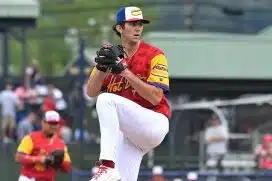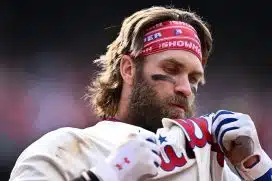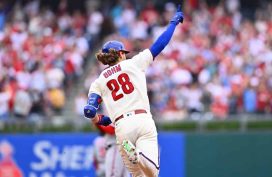By Tal Venada, Sports Talk Philly Contributor
While the Philadelphia Phillies faithful helplessly witnessed the spending frenzy in the majors, they now feel only their team did nothing. But the New York Yankees are applying the same method, plus the Los Angeles Dodgers and Boston Red Sox have had limited activity. Basically, not overpaying.
Contractual Consequences:
For many Phillies fans, they will carry disappointment through the weeks ahead. And when the campaign begins, they will point out successful players inked before the lockout. Ergo, they will only mention the highlights, but they will be blind to the poor signings and the desperation moves leading to other teams’ difficulties.
IN OTHER WORDS:
“Sooner or later everyone sits down to a banquet of consequences.” – Robert Louis Stevenson
With a deadline of Dec. 2, many franchises chose to either meet a player’s asking price or overpay to secure his services. They believe they won’t have a last-minute rush to construct their rosters if the negotiations last two months. Yes, Feb. 1 is the anticipated date leaving 2-3 weeks to be ready for spring training.
The Fightins are in the group taking the deliberate approach. Basically, the remaining stars will compete for offers from like-minded execs, who will want to field the strongest –not the most expensive– active 26. But while there will be less available talent, there also won’t be many organizations going overboard.
Some expect another spending frenzy when the new CBA (collective bargaining agreement) takes effect. However, anticipating franchises to ink more top-dollar stars is questionable because this time the players may be under more pressure to find a landing spot.
Because owners don’t want to lose games (money) due to CBA negotiations, expect a two-month lockout and minor league signings. Plus players will have 2-3 weeks to finalize deals and make housing accommodations for camp and the summer. One exception: Those near the final contractual stages could happen quickly.
To illustrate the opposite, the New York Mets were the champions of overpaying: They extended a third-season proposal for Max Scherzer versus the Dodgers’ two. Moreover, they inked Starling Marte for $2 million less than his $80 million projected cost for four campaigns.
For a club, the risk is only having 14-21 days to complete their 26-man roster, even though they may have potential agreements more than halfway complete. Some stars, unfortunately, have the fear of missing all or part of spring training due to a monthslong lockout.
Because money is the main issue, none of the on-field rules have been on the table like the universal DH, a tacky ball, and other in-game issues. So, Dave Dombrowski, POB (president of baseball operations), will be in for 8-9 weeks of waiting. Don’t expect a miracle!
The MLB’s latest proposal for the CBT (competitive-balance threshold) is an increase from $210 million to $214 million, but the ending is $220 million for the fifth year. Basically, it’s the same $2 million increase per summer of recent 162s. But the MLBPA (players association) wants the fifth season to be $240 million, not $220 million.
Even though teams can’t contact players or agents, the execs can work on more than inking players to MiLB contracts: GMs can put trades together. Therefore, they may immediately announce a few swaps under the new CBA besides free-agent signings nearly completed before the lockout.
The Phillies have a center field possibility with the Tampa Bay Rays for Kevin Kiermaier, who is a strong defender and bounced back with a .259 average for ‘21, plus he has a 2023 club option. But although his current salary is $12 million, his AAV (average annual value) is $8.9 million. So, he could be here for 1-2 years.
Using every ounce of AAV payroll space, the POB would have $29.6 million AAV to reach the $214 million threshold. Realistically, this includes Scott Kingery on the active 26 and a miniscule raise for Ranger Suarez. But the midpoint between the majors and the players union is $222 million for 2022.
To ink a $20 million AAV left fielder and trade for Kiermaier’s $8.9 million AAV, the Phillies would be at $213.3 million AAV and have 22 slots filled with four spots open: two relievers and two reserves for $2.4 million to $215.7 million AAV. But if you give Suarez a $1 million pact, the new tally would be $216.1 million AAV.
In the pen, Corey Knebel, 30, has closing experience, is healthy; and his stuff is completely back. In fact, 2021’s 2.45 ERA is his best since 2017’s 1.78 ERA with 39 saves for the Milwaukee Brewers. Ergo, Jose Alvarado, Seranthony Dominguez, Connor Brogdon, Sam Coonrod and two others will round things out.
Besides spending $10 million for Knebel –his heater averages 96.5 mph and touches 98.6 mph– Dombrowski signed Johan Camargo, a versatile utility infielder, for $1.4 million: a nice pickup of an arb-eligible player who had earned $1.36 million in ‘21. Therefore, both inkings were reasonable financial additions.
Reports out of New York City have the red pinstripes acquiring Kyle Schwarber, 29 on March 5, for a $60 million, three-year pact referred to as a bargain. As a leadoff man, he hit .297 with 17 bombs and 30 RBIs for 101 at-bats. So, the Phils could have a closer, a center fielder and a left fielder in the leadoff spot.
To sum up, organizations after the no-attendance 2020 and 2021’s monetary losses can hold out for two months without jeopardizing 2022’s revenue. Then, the Phillies could sign Schwarber, trade for Kiermaier, have a battle for the other four slots in Clearwater; and the moves for those outfielders could be where on Feb. 1? In place!
NEXT:







